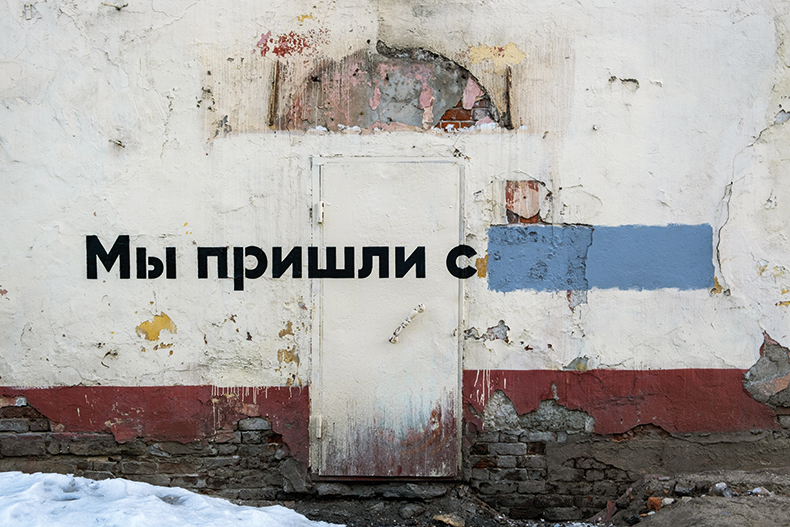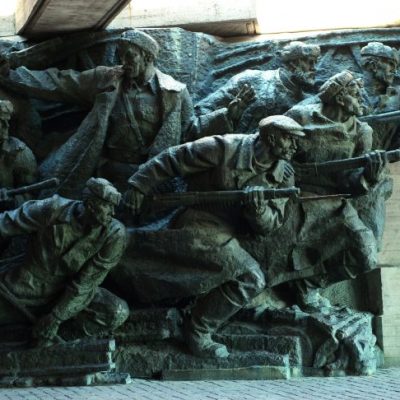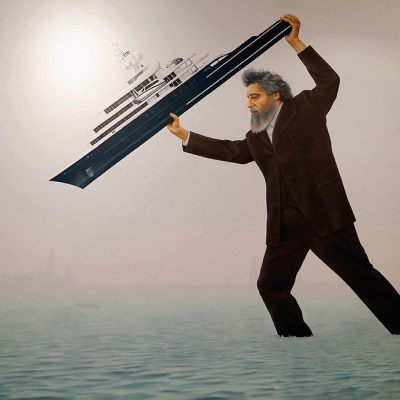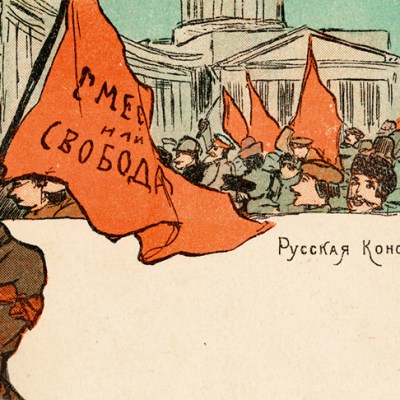From the July/August 2022 issue of Apollo. Preview and subscribe here.
After Russia launched a full-scale invasion of Ukraine on 24 February 2022, the Russian artist Alisa Gorshenina saw no point in making art. Speaking on the phone from her home in the city of Nizhny Tagil, in the Urals, the 28-year-old – who calls herself Alice Hualice on Instagram – tells me that when she woke up to the news, she roused her husband by telling him there was a war and that her first thought was to react publicly, stating her position. The next day Gorshenina walked up a slope that is a tourist attraction in the industrial town and planted a big placard, on which she had written ‘NO TO WAR’ in the snow. Nizhny Tagil is a small town.
The single picket made the local news and prompted negative comments but it stayed up for two weeks, according to the artist. A few days later, she put up a sign saying ‘NO TO WAR’ at her window. ‘At first I thought I had died as an artist. And then I came back to art – to resistance through art,’ Gorshenina explains. Next, she sewed the words ‘NO TO WAR’ and tear-shaped pieces of fabric on to a black coat and walked down the city’s Peace Street. ‘Some people ignored me, some women watched me with understanding in their eyes, some men shouted that I was insane. I’d say that the official statistics don’t represent how people feel. There’s a lot of people who disagree with the war in secret,’ Gorshenina says. ‘The following day [the authorities] forbade [us] from using the words “No to war”, so we’ll have to invent new ways of saying it,’ she adds.
After 24 February, the United States, the EU and others introduced wide-ranging sanctions against Russia with the aim of crippling the country’s economy. These sanctions targeted billionaires believed to be close to the Kremlin, some of whom had been funding key art institutions such as the Garage Museum of Contemporary Art (co-founded by Roman Abramovich) and the V-A-C Foundation (co-founded by the natural-gas magnate Leonid Mikhelson). This revealed what we had known all along: that oligarch-funded institutions weren’t far from the state.
Ukrainians had more immediate concerns, such as survival, and many artists and cultural institutions turned to volunteering and raising funds, with galleries and art centres becoming temporary bomb shelters or places for the internally displaced to stay. Russians of course didn’t face such hardships, but for artists and people who work in culture it still felt like a decisive time. Fears that Russia would close its borders prompted people who had the means to do so to leave. Calls to boycott Russian culture started appearing from Ukraine and elsewhere. A few days after the invasion, the curator and two artists responsible for the Russian Federation’s pavilion at the Venice Biennale resigned, cancelling the country’s participation in the event. The Italian art director of the V-A-C Foundation also resigned shortly after the invasion. The foundation had recently opened GES-2, a vast exhibition space close to the Kremlin that was intended to be Moscow’s answer to Tate Modern. Several artists, both from Russia and abroad, asked for their work not to be exhibited by GES-2. The Art Russia fair, on the other hand, still took place at the end of the March, with many Russian artists taking part as if nothing had happened.
Russian artist Vadim Zakharov standing in protest in front of the Russian Pavilion during the 2022 Venice Biennale. Photo: © Vadim Zakharov

For Russian artist Vadim Zakharov, the red line he won’t cross – he refuses to collaborate with an oppressive and murderous regime – appeared years ago. The artist, now 62, represented Russia at the Venice Biennale in 2013 and possesses a large archive of Moscow conceptual artists. ‘Russia occupied Crimea in 2014. If I had been invited to represent Russia after that I would have said no,’ Zakharov tells me, speaking from his home in Berlin.
This year, Zakharov stood in front of the Russian Pavilion in Venice with a placard that stated: ‘I protest against Russia’s propaganda and the Russian invasion which led to the war in Ukraine. The murder of women, children, people of Ukraine is a disgrace to Russia. I am standing here in front of the Russian Pavilion against the war and against Russian government cultural ties.’ Zakharov insists this was a political statement, not an artistic ‘action’ or a performance. He thinks that artists should speak out against the war, but, he adds, ‘My opinion, which is not a very popular one, is that Russian artists and members of Russia’s cultural sphere should keep silent [about art], at least until the war is over.’
Zakharov’s career started in the late 1970s when he and his friends (among them Ilya Kabakov) used to put on exhibitions of Unofficial Art in their apartments. He has known completely different worlds, having also experienced – as a successful artist after the fall of the Soviet Union – how the Russian art scene is structured and the power of the large oligarch-funded institutions. ‘This should be a pause or a break,’ Zakharov says. ‘Creative people should be collecting, analysing the [current] situation for the future.’
To some extent, Zakharov’s desire for a break goes hand in hand with his hopes for the return of greater artistic autonomy for artists. ‘Artists can organise lots of things today, not ask for sponsoring, nor wait for collectors or galleries,’ he says. Zakharov also believes that Russian and Ukrainian artists are at a turning point and that the ties established between Russian culture and the West over the last decades could disappear. ‘Everything is closing down for [Russian artists]. But for Ukrainian culture, everything is opening,’ he says.
It is striking that many of the anti-war activists and many of the artists protesting against the war are women. Although, as Gorshenina tells me, ‘Most of the protesting against war comes from activists rather than from artists. As for artists, there’s not that many big names, artists who have won prizes or have exhibited their work in big museums such as Garage.’ (She received a grant from the museum in 2019 and participated in its second Triennial.) ‘I think it’s logical that the anti-war movement has a woman’s face,’ Gorshenina says. ‘Anti-war movements often do. We react harder to injustice because we face it all the time.’
Russian-speaking feminists have created a horizontal organisation called the Feminist Anti-War Resistance that focuses on small actions, rather than mass protests, such as ‘women in black Thursdays’ and trying to counteract official propaganda in the form of, for example, graffiti or messages on banknotes. Aleksandra Skochilenko, a 31-year-old artist and musician, followed the group’s example when she substituted price tags with information about the war in Ukraine in a food store in St Petersburg. Her friend Anastasia Williams, who migrated to the United States eight years ago, tells me that Skochilenko was denounced by an older woman who reported her to the store’s manager and then to the police in April. Skochilenko was one of the first to be charged under the new criminal statute for ‘discrediting the Russian armed forces’. Prosecutors have said she was motivated by ‘political hatred of Russia’. She faces up to 10 years in jail.
Moscow street artist Andrey Toje’s work across a wall in Kolomna in March 2022, reading ‘We came —’. Photo: © Andrey Toje

Aleksandr, a street artist from Moscow who doesn’t see himself as ‘an artist’, tells me that anti-war inscriptions have multiplied on the walls of the capital. ‘You can tell that most of them are done by ordinary people. I haven’t seen much from the big graffiti artists,’ he says, speaking over an encrypted messaging app. ‘Every time someone does graffiti against the war it’s immediately taken out by municipal workers or by labourers [often migrant workers from Central Asia], a lot of whom struggle to read in Russian.
So you have to beat them to it. You have to disguise what it is that you’re saying, so that these workers don’t understand it but everyone else does,’ he explains. In March, Moscow street artist Andrey Toje wrote ‘We came with —’ (the last word covered up by paint) on a wall in the town of Kolomna, a reference to the Russian phrase ‘we came in peace’. On 9 May, Victory Day in Russia, an artist working under the pseudonym Philippenzo Madonnaro drew rows of coffins on a wall in Volgograd and wrote ‘Zinc is ours’, an allusion to the closed zinc coffins in which Soviet soldiers who died in Afghanistan were sent back home – and a reference to the 2004 slogan ‘Crimea is ours’.
Many artists have left. Sometimes, those who are in exile sound even more bereft than those who have remained in Russia. Artem Loskutov, an artist from Novosibirsk, is known for having created an annual ‘Monstration’ (a subversion of the traditional May Day procession) in his hometown. It hasn’t taken place for 3 years. On 24 February Loskutov was out of the country and he hasn’t gone back. ‘I don’t want to end up in jail,’ he says, speaking on the phone from Riga. ‘I ended up in jail 13 years ago and I understood how the court and the police operate – they don’t need any evidence to send you to prison. It’s gotten much worse now. They can arrest you and you could sit in jail until the end of the war. When I think of Russian art, I have a feeling of defeat. We did all this and today it seems it has no value. If I had known that a war would start in 2022, what should I have done?’
Alisa Gorshenina (b. 1994) photographed in April 2022 in Nizhny Tagil. Photo: © Alisha Gorshenina

Others see it differently. ‘I thought I’d be more useful here. Leaving would be safer, but I’ll take the risk,’ Gorshenina says. After it became a crime to call the war a war, Gorshenina sewed the word ‘pain’ in native languages used across Russia over a long black garment. ‘The war has revealed our internal problems. Russia has gone to “denazify” another country. Why doesn’t it pay attention to the discrimination happening here?’
But is there any point, I wonder, in protesting inside Russia? Williams, who worries for her friend Skolichenko, says: ‘Will such small actions stop the war? No they won’t. They won’t stop the bombing […] It will make a person who thought they were alone in not supporting the war feel connected. And I think, once the war is over, we will understand the value of these little things, because they will help society transform faster and maybe know what to do after war is over.’
Meanwhile, the war continues and though some Western commentators have been hoping for a coup, Vladimir Putin’s regime shows no sign of losing its grip on power. As for being scared of the consequences, Aleksandr says, ‘Just for how much longer can we be scared? I understand that I’m right.’
From the July/August 2022 issue of Apollo. Preview and subscribe here.


